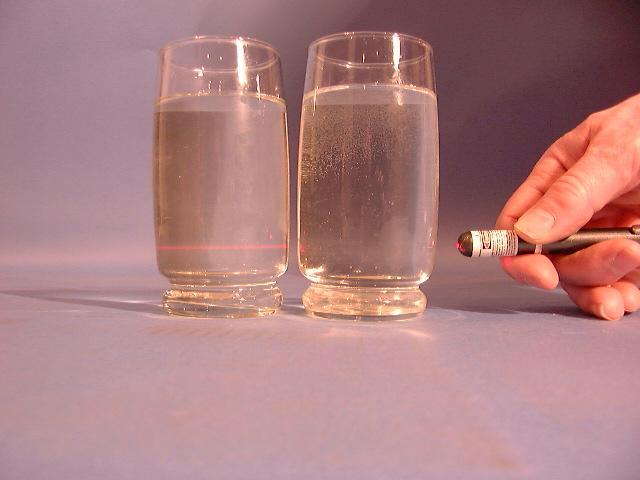Demonstration of Tyndall Effect or Tyndall Scattering in Colloidal Systems
What is common between the blue irises (eyes) and the car-headlight beams visible on foggy nights? Both arise from Tyndall effect or Tyndall scattering - the scattering of light by fine particles dispersed in a light-transmitting medium. If a beam of light passes through an optically transparent dispersion medium, the path of the beam becomes visible when viewed at right angle to the direction of the incident light beam (Figure 1). The phenomenon of scattering of light by suspended particles is known as Tyndall effect or Tyndall scattering, named after the Irish scientist John Tyndall who first studied it extensively (in 1869). The luminous path that results from the visible scattering along the path of light beam is called "Tyndall Cone" or Tyndall beam. Tyndall effect is observed when light falls on particles of cross-sections in the approximate 40 and 900 nm range suspended in a transparent medium. Such media are nothing but colloidal systems. We know that in colloidal systems are those where particles of roughly 1 nm (10-9 m) to 1 μm (10-6 m) sizes are dispersed in a continuous medium. Tyndall effect is therefore used in identifying whether a mixture is a colloid, pure liquid or a true solution. Visible light scatters in various directions in a colloidal dispersion whereas a pure liquid or a true solution does not show luminous path scattering. Therefore, the observation of Tyndall effect indicates the existence of a colloidal dispersion. This effect has been observed in colloids with as low as 0.1 parts per million (ppm) of dispersed phase.
Some familiar observations such as the illumination of dust particles by the light beams in a room or on a dusty road, beautiful colours of many gem stones and opalescent glass, twinkling of stars, and the visibility of comet tails are examples of Tyndall effect. The fascinating blue and green colours of many animals such as chameleons and some frogs, damselflies, dragonflies, and birds have their origins also in the Tyndall effect (when the colour is not arising from interference/iridescence). In fact, animal body (melanins) can synthesize pigments of brown to black, yellow and red colours or can obtain them via ingestion of foods (carotenoids). Blue or green coloured pigments are hardly synthesized by the animal body. However, light scattering by various suspensions of pigments in the animal body can give rise to blue and green colours. Tyndall scattering has been used in instruments like ultramicroscope and turbidimeter to determine the size and density of particles in aerosols and other colloidal systems. Tyndall Effect

Figure 1. Demonstration Tyndall effect. A laser pointer has been used as light source. The left glass contains 5 ppm of colloidal silver and the right one tap water. The path of the light beam can be clearly seen in the left glass. (Courtesy:http://silver-lightning.com/tyndall/tyndall3.jpg)
